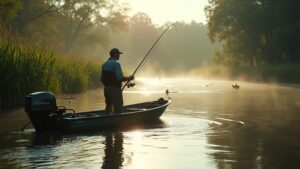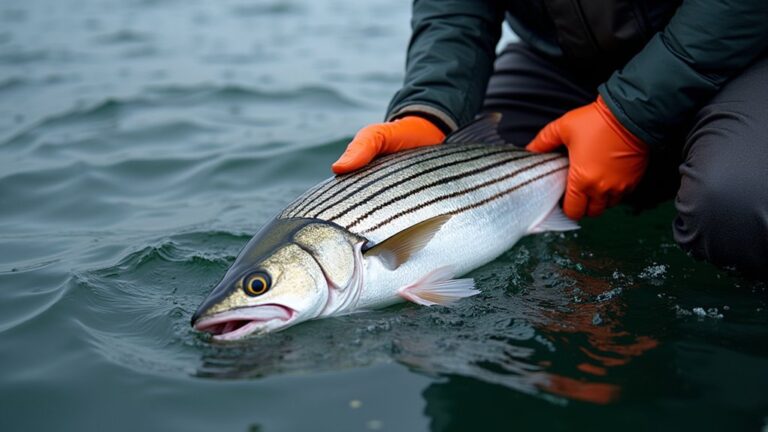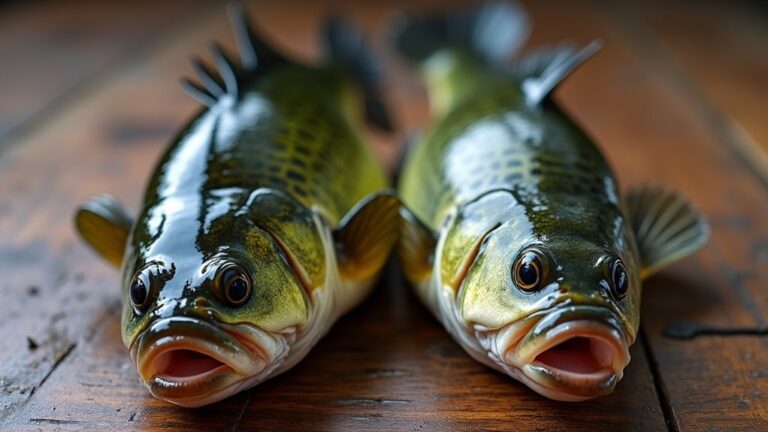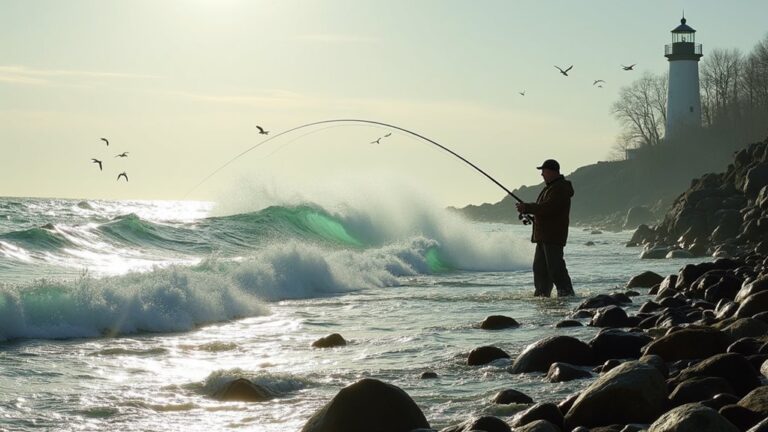You’ll find the best redeye bass in cool, rocky headwater creeks and small rivers across the Southeast, especially in Alabama’s Coosa and Tallapoosa drainages. Fish upstream of the Fall Line where flowing, shaded runs, riffles and pools hold schooling fish; Georgia, South Carolina and Tennessee have pocket populations in similar habitats. Use light gear, topwater or small flies in spring–early summer, and favor protected public reaches or guided access—keep going to learn specifics on spots, tactics and conservation.
Important Takeaways
- Primarily in the Coosa River basin (Alabama/Georgia), especially cool, flowing headwaters above the Fall Line.
- Tallapoosa tributaries and upper Mobile Basin streams hold pure populations in less disturbed headwaters.
- Small to medium rocky creeks and pools with overhangs and riffle–pool transitions across Alabama, Georgia, Tennessee, and South Carolina.
- Border and headwater streams feeding the Coosa offer better chances for purer redeye populations versus hybridized mainstem reaches.
- Use public reaches, conservation areas, or guided access on private waters; target spring–early summer surface activity near shoals and structure.
Redeye Bass Range and Native Drainages
Where do redeye bass live, and where should you look for them? You’ll find redeye bass primarily in the Coosa River basin and other native drainages across the Southeast United States. They favor small to medium rivers and creeks with cooler, flowing water—often above the Fall Line—rather than stagnant lakes or ponds. Look for rocky bottoms, pools, and spots with overhanging cover, submerged rocks, or stumps where current breaks provide ambush points.
Several regional varieties occur across Southeastern drainages, with different populations confined to particular streams and even private lands, so local knowledge helps. Reports also place them in nearby states, but the core of their native range remains concentrated in the Coosa drainage. Blue marlin and other offshore species are part of the Carolinas’ diverse saltwater fauna, making the region notable for both inshore and offshore fishing opportunities, including Yellowfin Tuna and mahi-mahi.
Key Redeye Hotspots in Alabama
Looking for redeye bass in Alabama? You’ll find them primarily in the Coosa River basin and its tributaries, especially in central and southern waters where cool, flowing creeks and small streams feed the system. Focus on rocky-bottom sections, undercut banks, and structure—overhanging trees and submerged rocks—where pools and runs above the Fall Line hold 6–10 inch fish. Target headwater creeks and protected reaches, since hybridization and illegal bucket stocking have diminished pure populations in some areas. Work a sequence of micro-ecosystems: blue-lined first-order streams, midstream riffles, and shaded pools with topwater poppers for surface strikes. Fish selectively, respect regulations, and prioritize conserving these pockets of Alabama redeye bass habitat. Consider using a kayak for stealthy access to tight headwater reaches and shallow structure, since its exceptional water accessibility lets you reach spots larger boats can’t.
Georgia Streams Worth Exploring
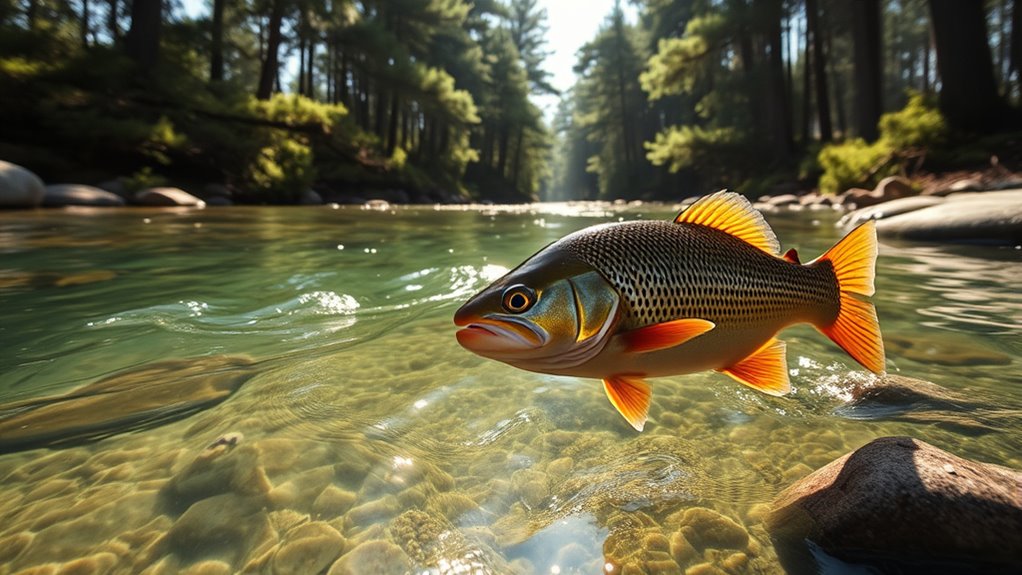
Curious where to find redeye bass in Georgia? You’ll want to focus on Coosa River basin tributaries and cooler, flowing Georgia streams with rocky bottoms and overhangs. Fish late spring into summer, casting topwater poppers or terrestrial fly patterns around riffles, pockets, and rocky runs. Protecting habitat matters — watch for sedimentation and avoid illegal stocking that causes hybridization.
- Target small to medium rivers with structure and steady flow.
- Explore Ocmulgee and Conasauga drainages for native populations.
- Prioritize border streams feeding the Coosa system for purer fish.
- Use fly fishing techniques and topwater offerings near rocky runs.
You’ll increase success by matching presentation to current flow and cover. The HT Enterprise Polar Therm Extreme tip-up’s freeze-proof design illustrates how gear built for harsh conditions can improve persistence and effectiveness in challenging fishing environments.
South Carolina Rivers and Creeks
Want to chase redeye bass in South Carolina? You’ll find them in a limited swarm of rivers and creeks within the upper Coastal Plain and western foothills, usually above the Fall Line where cooler, flowing water persists. Target rocky-bottom creeks and small to medium rivers with overhanging trees, submerged rocks, and rocky shoals—those features offer cover and spawning sites. These Micropterus show distinct vertical bars, a dark gill spot, and the red-tinted eye that sets them apart. Spawning runs late spring into early summer when flow supports nests. For anglers, topwater presentations in slow to moderate currents work well; cast poppers or terrestrial flies near structure and shoals to provoke explosive surface strikes on local tributaries. Many redeye bass populations are vulnerable to habitat loss and hybridization pressures, so localized habitat protection efforts are important for preserving native populations.
Tennessee Pockets for Redeye Sightings
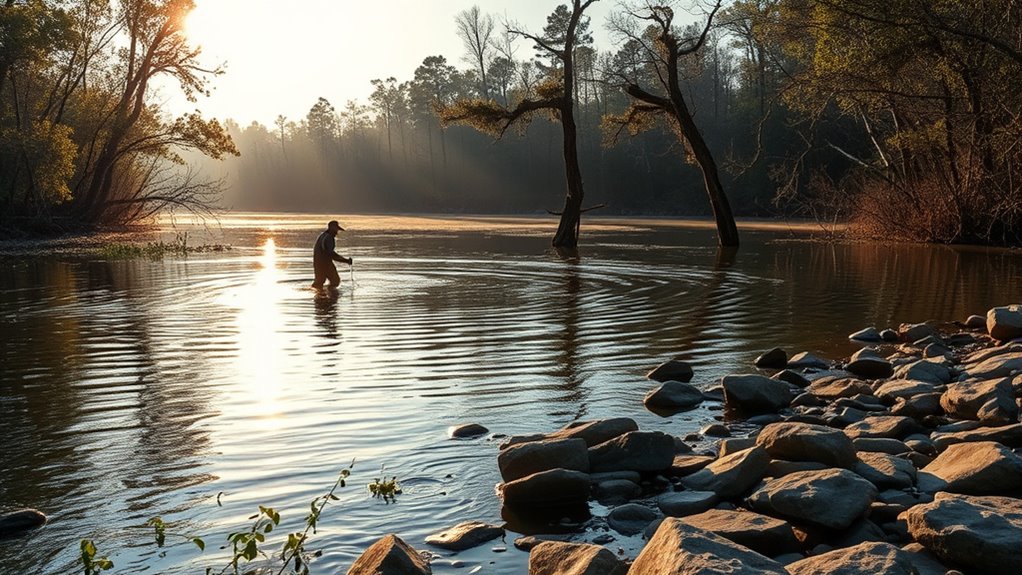
Where in Tennessee should you focus your search for redeye bass? You’ll want to target cool, flowing streams and headwater pockets where rocky bottoms, overhanging vegetation, and moderate to strong current create ideal holding water. Fish these riffle-pool transitions and ledges in upper basins, especially during late spring into summer when surface feeding picks up. Watch for subtle coloration and gill-spot patterns to separate pure redeye from hybrids.
- Small creeks with rocky substrate and current.
- Riffle-to-pool pockets along upper river branches.
- Overhanging-vegetation cutbanks and submerged ledges.
- Headwater tributaries feeding larger basins.
Scout maps, time your outings for higher activity, and carry photo ID notes to confirm redeye bass in Tennessee pockets. Consider using braided line on a braided line ready spool when fishing around heavy cover and current.
Tallapoosa and Coosa River Systems
If you’re targeting redeye bass in the Tallapoosa and Coosa systems, focus upstream of the Fall Line where cooler, flowing creeks and small rivers hold fish around rocky shoals, submerged structure, and overhanging cover; pure redeye persist in select headwater pockets while hybrids with Alabama bass show up in more connected stretches, so watch gill-spot patterns and subtle coloration to confirm your catch.
You’ll find the Tallapoosa’s pure populations increasingly restricted to less disturbed headwaters, while the Coosa basin contains multiple redeye varieties but has notable hybridization history from past stocking and range shifts.
Fish cooler runs, probe shoals and woody cover, and adjust presentations for stream versus larger river sections to improve hookups. Compact, sensitive gear helps. Combine this with timing trips around tidal movement and early morning or late afternoon feeding windows to increase success.
Small-Stream Tactics for Finding Redeyes
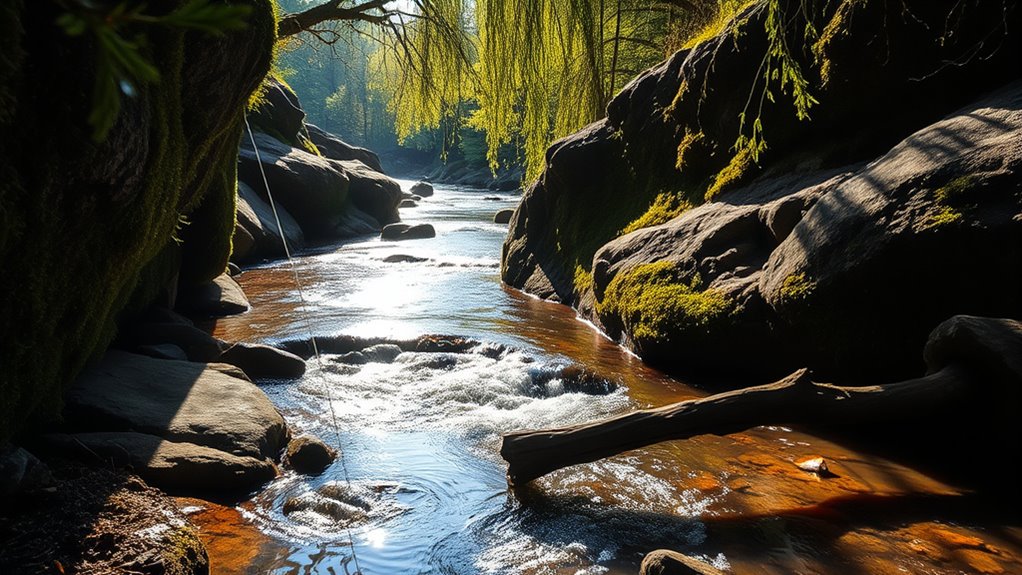
Looking to dial in redeye action on small streams? You’ll focus on rocky-bottom pools, submerged rocks, overhanging vegetation, and current breaks in cool, well-oxygenated shallow creeks. Approach from downstream, cast into deeper pockets and behind cover first, and favor tight, shaded spots where structure holds fish.
- Pick streams above the Fall Line in AL, GA, SC, or TN where populations persist.
- Target rocky shoals and current seams; fish close to the current break.
- Use small topwater poppers, terrestrials, or flies sized 8–10 for streams (4–6 on bigger rivers).
- Apply stealthy fly fishing techniques and short, accurate casts into fast-water pockets.
Keep presentations compact and precise to trigger aggressive redeye bass strikes. Many anglers also time their outings around the last hour of the dropping tide when similar shallow-water feeders concentrate along edges and flats.
Seasonal Patterns and Best Times to Fish
Once you’ve dialed in spots and presentations on small streams, timing becomes the next big edge for catching redeyes. You’ll find redeye bass most active late spring through summer in the Coosa, Tallapoosa, Cahaba, and Warrior basins when spawning and feeding peak in flowing creeks and small rivers. Expect peak topwater fly action in May–June as poppers draw strikes from schooling fish near overhangs and rocky shoals. In larger rivers, moderate temperatures can extend productivity into early fall. Come late fall and winter, redeyes retreat to deeper, shaded, cooler sections of stream habitats, reducing surface activity. Match fly colors to seasonal patterns: white/yellow/chartreuse for May–June, blue/orange July–August, black/green September–October. For long days on the water bring a multi-piece rod to stay mobile and protected while chasing schooling redeyes.
Access, Guides, and Local Angling Resources
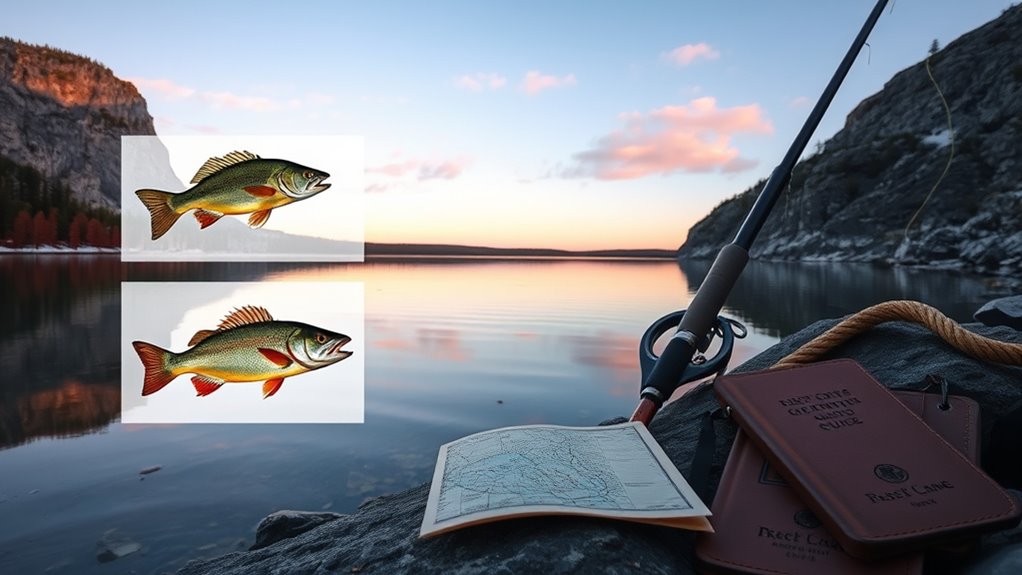
Where can you fish redeye bass without trespassing or wasting time? You’ll focus on public reaches of the Coosa, Tallapoosa, and Cahaba drainages and cool, flowing creeks above the Fall Line. Use guides and local fly shops for legal access, permits, and up-to-date spots.
- Contact local fly fishing shops for guided float trips and maps.
- Hire conservation-aware guides who know pure vs. hybrid populations.
- Ask about private-water permissions through established networks.
- Target shoals and overhanging structure in late spring–summer with topwater poppers.
Guides like Rowell Guevarra offer itineraries that combine access, ecology, and gear. You’ll save time, avoid trespass, and improve redeye bass hookups by leveraging local expertise. The all-metal construction and durability of some reels make them a reliable choice when fishing for redeye bass in faster currents and around structure, especially when paired with a smooth drag system and proper technique for long casts to distant spots like shoals and overhangs all-metal body.
Conservation Areas Protecting Redeye Habitat
After you’ve used guides and local shops to find legal access, it helps to know which conservation areas actually protect redeye bass so your fishing stays sustainable. You’ll look for protected corridors in the Coosa and Mobile basins, plus pockets in the Carolinas, Kentucky, Mississippi, Florida, and Tennessee where conservation areas prioritize cool flowing streams and riffles.
Those zones maintain rocky cover and strong flow needed for spawning and limit development and pollution.
On private lands, partnerships with landowners and guides extend protection and access while reducing harm to redeye habitat.
Managers also monitor hybridization risk with Alabama bass in basins like Warrior and Cahaba, using targeted protections and stocking rules to preserve genetically pure populations.
Final Thoughts
You’ve now got the lowdown on where redeye bass live and how to find them across their range. Head to clear, rocky creeks and small drainages in Alabama, Georgia, South Carolina and Tennessee during spring and fall, and use light tackle, small lures and stealthy approaches. Check local access points, hire a guide if needed, and respect conservation areas to keep populations healthy. Get out there, fish smart, and enjoy chasing these feisty natives.

